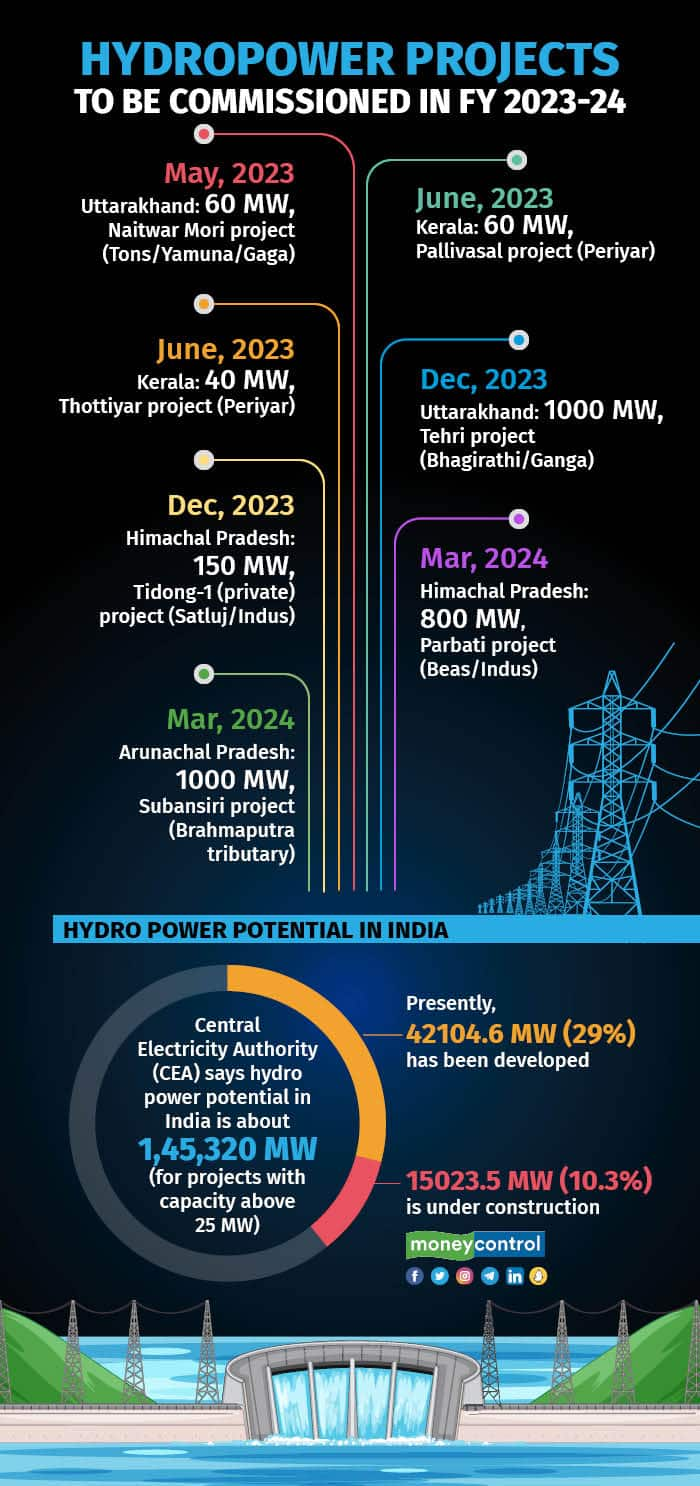



Seven hydropower projects with a total capacity of 3,110 megawatts (MW) will be commissioned in the financial year 2023-24 that begins on April 1, government data reviewed by Moneycontrol shows, as the Centre steps up efforts to narrow the demand and supply gap.
Of these, three projects, with a total capacity of 140 MW, are likely to get operational in May and June, when the demand for electricity is expected to see a sharp surge.
Since no hydropower capacity addition is expected in April, identified as a “crunch period”, the government has asked producers to re-start at least two non-operational hydropower projects – Kishenganga in Jammu and Kashmir and Sainj in Himachal Pradesh.
"As Grid-India has forecast, peak hydro availability in April this year is likely to be 18 percent below what it was last year because the India Meteorological Department (IMD) has predicted a hot and dry summer for most of India, which will adversely impact rainfall," a power official said, requesting anonymity.
Overall, hydropower contributes about 11 percent to India's energy mix, the official said.
Hydropower is a considered a flexible generator. Unlike coal-fired plants, these units can be ramped up and down quickly to in keeping with the power demand.

Early this month, the government reviewed the timelines for under-construction hydropower projects, after which the deadline for the commissioning of seven projects was pushed to the next financial year.
These are Naitwar Mori (60 MW) and Tehri (1,000 MW) in Uttarakhand, Pallivasal (60 MW) and Thottiyar (40 MW) in Kerala, Tidong-1 (150 MW) and Parbati (800 MW) in Himachal Pradesh and Subansiri (1,000 MW) in Arunachal Pradesh.
If the revised timelines are adhered to, the country will see an increase of 2,990 MW in hydropower generation from the current financial year. As per provisional data till February 28, India could add only 120 MW of hydropower capacity in FY 2023.
Tapovan Vishnugad Phase 2 on holdAs per the plan, the commissioning of a part of the controversial Tapovan Vishnugad project has been pushed to December 2024.
For the second part, the government has done away with the deadline altogether stating, saying the project in the Chamoli district of the hill state of Uttarakhand has been stalled “until further orders”.
The project has faced stiff opposition from locals and a section of environmentalists who blame it for Joshimath’s land subsidence.
According to the Central Electricity Authority (CEA), India has a hydropower potential of about 1,45,320 MW (for projects with a capacity above 25 MW). But at present, 42,104.6 MW (29 percent) out of the identified potential of 1,45,320 MW has been developed and 15,023.5 MW (10.3 percent) is under construction.
“The main challenges in the development of hydroelectric potential in the country are remote location, unpredictable geology, natural calamities, environment and forest issues, Rehabilitation and Resettlement (R&R) issues, law and order issues and inter-state issues,” Union power minister RK Singh told the Rajya Sabha on March 21. He was responding to a question on the underutilisation of hydropower plants in the country.
Power-packed NEThe north has 19,696.3 MW installed hydropower capacity, the highest among all regions. The south has 9,741.6 MW in operation, while the western region has 5,552 MW. The east has 5,087.8 MW and the northeastern region has 2,027 MW.
The north also leads in new projects, with 7,366.5 MW of units coming up in the region. But, it is the Northeast that the government is looking to tap into. Projects with an installed capacity of 5,000 MW are being built in the region, the second highest in the country.
The government is also looking beyond the scheduled 5,000 MW to plan new projects in the area, sources told Moneycontrol. This is as much for geopolitical reasons as it is for ensuring energy security through renewables. China is on a mega dam construction spree on the stretches of Brahmaputra, called Yarlung Tsangpo there, which passes through its territory. As per government data, the Brahmaputra alone can meet 40 percent of India’s hydropower potential.
The other regions will likely see an incremental increase in installed capacity, with the west adding 400 MW, the south 1,100 MW and the east 1,157 MW under construction.
Discover the latest Business News, Sensex, and Nifty updates. Obtain Personal Finance insights, tax queries, and expert opinions on Moneycontrol or download the Moneycontrol App to stay updated!
Find the best of Al News in one place, specially curated for you every weekend.
Stay on top of the latest tech trends and biggest startup news.